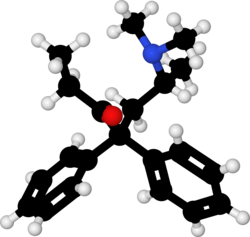 | |
 | |
| Clinical data | |
|---|---|
| Other names | Levomethadone; R-Methadone, l-Methadone; 6R-Methadone; (–)-Methadone; R-(–)-Methadone; D-(–)-Methadone |
| AHFS/Drugs.com | International Drug Names |
| Routes of administration | By mouth, IV, IM, SC, IT [1] |
| ATC code | |
| Legal status | |
| Legal status |
|
| Pharmacokinetic data | |
| Bioavailability | High [1] |
| Protein binding | 60–90% [1] |
| Elimination half-life | ~18 hours [1] |
| Identifiers | |
| |
| CAS Number | |
| PubChem CID | |
| ChemSpider | |
| UNII | |
| KEGG | |
| ChEBI | |
| ChEMBL | |
| CompTox Dashboard (EPA) | |
| ECHA InfoCard | 100.120.592 |
| Chemical and physical data | |
| Formula | C21H27NO |
| Molar mass | 309.453 g·mol−1 |
| 3D model (JSmol) | |
| Melting point | 99.5 °C (211.1 °F) |
| Solubility in water | 48.48 mg/mL (20 °C) |
| |
| |
Levomethadone, sold under the brand name L-Polamidon among others, is a synthetic opioid analgesic and antitussive which is marketed in Europe and is used for pain management and in opioid maintenance therapy. [1] [2] [3] In addition to being used as a pharmaceutical drug itself, levomethadone is also the main therapeutic component of methadone, which is a racemic mixture of levomethadone (R-methadone) and dextromethadone (S-methadone). [2] [4]
Contents
- Pharmacology
- Pharmacodynamics
- Chemistry
- Society and culture
- Generic names
- Brand names
- Legal status
- References
Levomethadone is used for narcotic maintenance in place of, or in some cases alongside as an alternative, to racemic methadone, [5] owing to concern that the cardiotoxic and QT-prolonging action of racemic methadone might be primarily caused by dextromethadone. [6] [5]